PORT WINE: WHAT THEY DO NOT TELL YOU ABOUT THIS WINE
Port wine is, quite possibly, Portugal’s most famous beverage. Even though we produce a myriad of other wines across the country’s distinct 14 wine regions, including 3 other fortified wines, namely Madeira, Moscatel and Carcavelos wine, Port is the sweet nectar connoisseurs associate with Portugal the most.
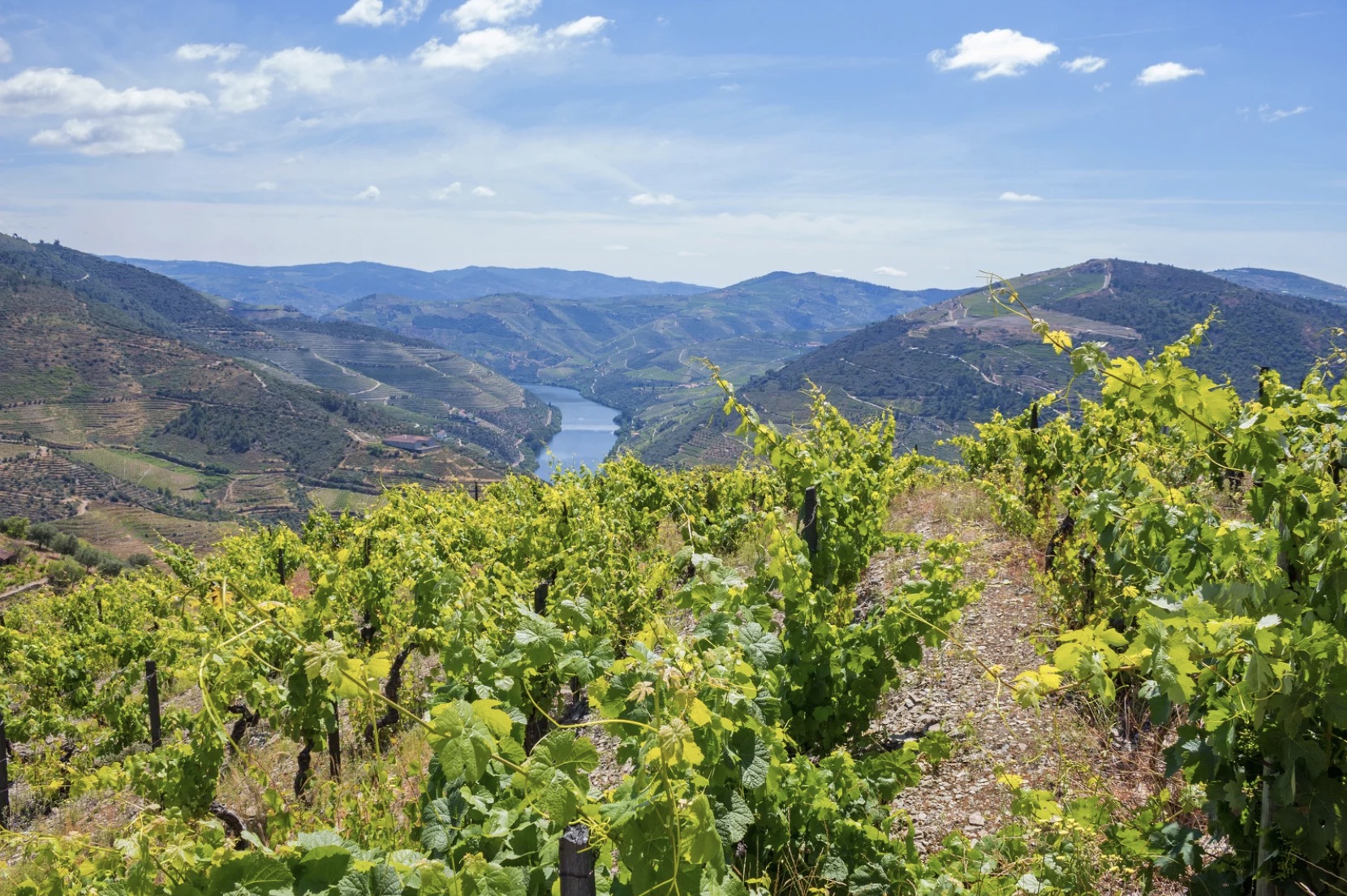
Douro valley vineyards
What is Port wine?
Port or Porto wine is generally regarded as a dessert wine, even though we believe looking at it from that lens is highly reductive. Of course you can enjoy Port with your pudding of choice, but you can also sip it as an aperitif, or use it in cocktail making. If you haven’t heard of Port tonic yet, for example, read until the end and learn how to make this refreshing Portuguese cocktail with us!
Simply put, Port wine is a Portuguese fortified wine produced in the north of the country, namely the Douro Valley which is linked with the city of Porto.
Fortified wines are those whose fermentation process has been interrupted by the addition of extra alcohol. During the wine making process, the naturally present sugar in grapes ferments and becomes alcohol. By adding a spirit such as brandy to the wine at a key moment of the procedures, fermentation is interrupted as the present yeast is killed. This results in a more alcoholic beverage, usually ranging between 19% and 22% in volume, because of the extra added distilled spirit while, simultaneously, the wine is also sweeter as a great part of the fruit sugars remain as such, before they are given a chance to transform into alcohol thanks to fermentation.
Fortified wine came about as a preservation method back in the day. Even though now-a-days we wouldn’t need to add extra alcohol to ensure wine remains stable in terms of quality and safety, fortified wines such as Port are today very appreciated for their particular taste and character.
Port wine is a strong, rather alcoholic and sweet wine from Portugal. Even though the world often thinks Port wine is a red wine, that isn’t necessarily the case, as there are several varieties of Port according to grapes used, the winemaking process, the aging of the wine and even the particularities behind a given year during which the wine was produced and/or bottled.
The Douro region where Port wine has been produced since the mid 1700s, is one of the world’s oldest wine regions and is also a UNESCO World Heritage Site. Port wine’s history is truly fascinating and we are about to explore it up next!
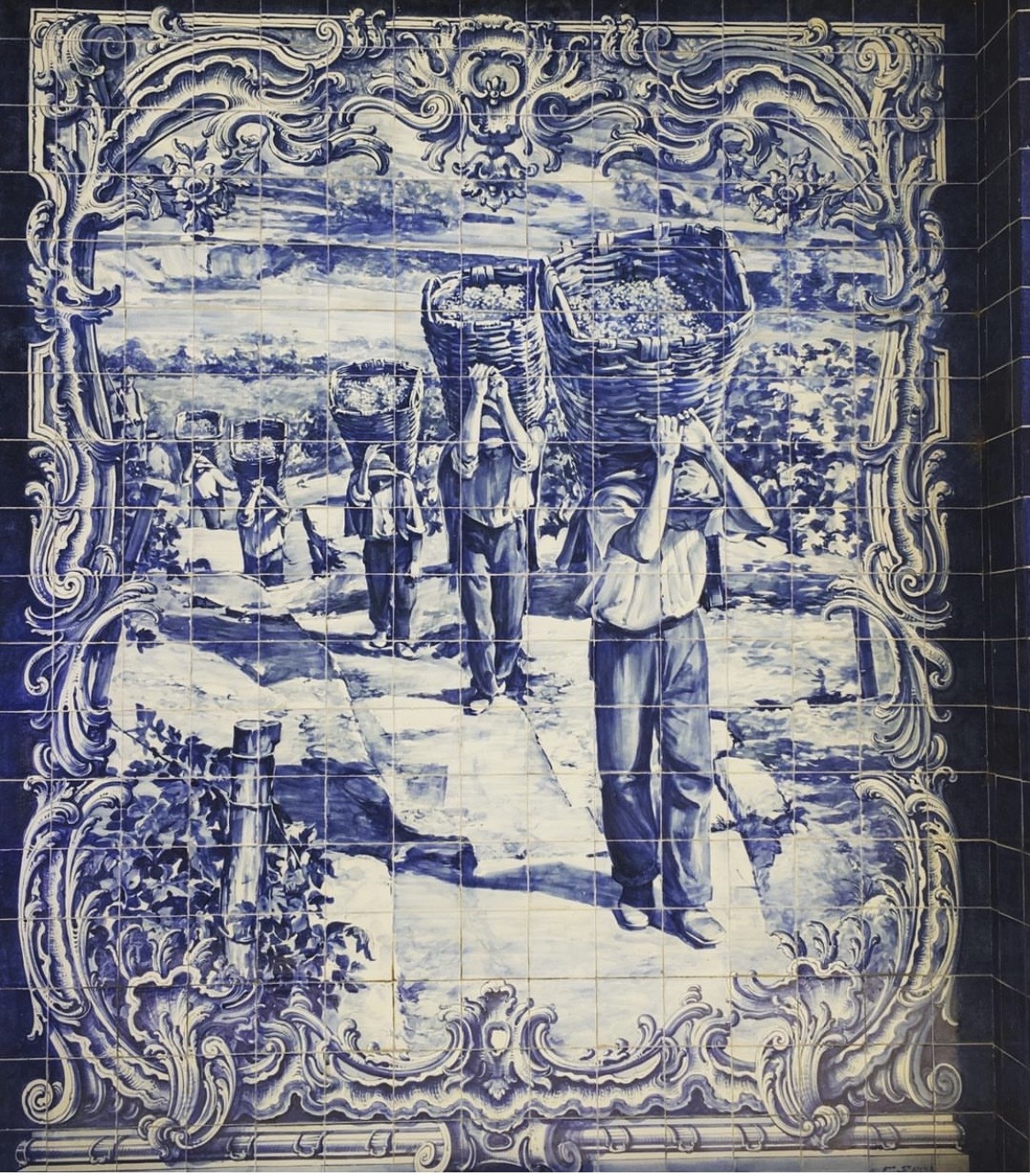
Harvest scene at Douro train station (©Silvia Olivença, August, 2020)
The history of Port Wine
Portugal has been producing wine for at least 2000 years. In the Douro region where Port is produced today, Romans whose empire extended to Portugal from the days before Christ until about the year 500, were already making very good use of the fertile lands of this part of Portugal back then.
Port wine with this specific designation only came about in the 17th century though. We’re talking about a period of history during which Portugal and England had a very close connection. So close that, until today, both countries have the oldest and still running treaty of any two countries in the whole wide world! Commercial relations back then translated into the export of wine from Portugal to England, in exchange of receiving our much beloved cod fish which we would locally transform into salt cod, that is, bacalhau.
The Anglo-Portuguese treaty which was signed in 1654 also granted British and Scottish businessmen special conditions to live and work in our country and this is directly linked with the fact that, still now-a-days, many of the most popular Port wine brands we know of, have English sounding names. Think about Taylor’s Port, Sandeman or Cockburn’s Port House, just to name a few. In parallel with the British presence in Portugal, the British-French connections were losing some strength. Until this point in history, Britain mostly relied on France to import its wine supplies from. But as custom duties were raised, the opportunity for Portuguese wine to start being exported to Britain saw a new light. This represented a sizable commercial opportunity for Portugal, which was furtherly worked on by the policies of Marquis of Pombal, the personality which would be the equivalent of a prime minister today, and who ruled Portugal and was responsible for its development from the mid 1700s onwards.
Fortification: from a merchant habit to modern technique
Back in the 1700s, wine from the Douro Valley started being exported to England by sea. As the boat rides were long and rocky, the wine wouldn’t arrive at its best. And so merchants started fortifying wine with a slug of aguardente in order to reduce the chances of spoilage, as this would protect the wine from oxidation during its long sea voyage. The fortification process at the beginning wasn’t as regulated as it is today. In fact, there were no guidelines on how to go about adding the grape spirit to wine, namely regarding the moment of the winemaking process during which this should be done, or even the quantities that would work best.
It was only at the beginning of the 1800s when fortification not only became commonplace but was also turned into a standardized procedure, where the grape spirit started being added directly at the winery, and before fermentation was completed. If it wasn’t for this uniformization of the fortification of wine, which stabilizes and locks in unfermented sugars, creating the familiar yummy style we have come to associate with this kind of drink, certainly Port wine as we know it today wouldn’t exist.
Where is Port wine produced?

Traditional ‘Rebelo’ boats were Porto wine is transported along Douro river.
Why is Porto wine called Port?
One would be quick to assume that Port wine is a beverage produced in the city of Port, Porto, or Oporto. But, in reality, Port wine is produced in the vineyards planted along the shores of the Douro river, which does indeed meet the sea by Porto, but actually extends all the way inland. In fact, the Douro river originates in Spain, where it’s known as the rio Duero.
Porto is the main city along the Douro region and it was indeed from here where Port wine was exported by boat back in the day. As it would have more of a ring commercially speaking, the wine started being called Port. It’s funny as this reminds us of how, in the past, Pico wine from the Azores archipelago was algo being commercialized as Faial wine.
The Demarcated Region of the Douro
There may be Port-style wines being produced in different parts of the word, for instance, Vinho Fontainhas in Goa, a former Portuguese colony in India. But only wine actually produced in the Demarcated Region of the Douro under very specific conditions resulting from natural and human factors, can be officially labeled as such. The Região Demarcada do Douro (RDD) extends between Barqueiros and Barca d’Alva, along the Douro river and its tributaries, and in an area of about 250,000 hectares of extension.
Port wine is a DO (denomination of origin) product, which is highly regulated, and has been so since 1756. This makes the Douro region one of the oldest demarcated wine regions in the world!
Today, the production of Port wine is overseen by the Port and Douro Wines Institute (IVDP – Instituto dos Vinhos do Douro e do Porto), a public institute created in 1933 under the Minister of Agriculture, with the aim not only of regulating the production and commercialization of Douro wine but to also bring together and support the wine producing community of this region.
The territories where Port wine is grown are classified according to a series of strict criteria, which cover different aspects such as location, inclination, sunlight incidence over a certain portion of land, age of the vine, and more. All of these characteristics together make the rather fluid concept of terroir, which is often used to describe the origin of wines and certain food products.
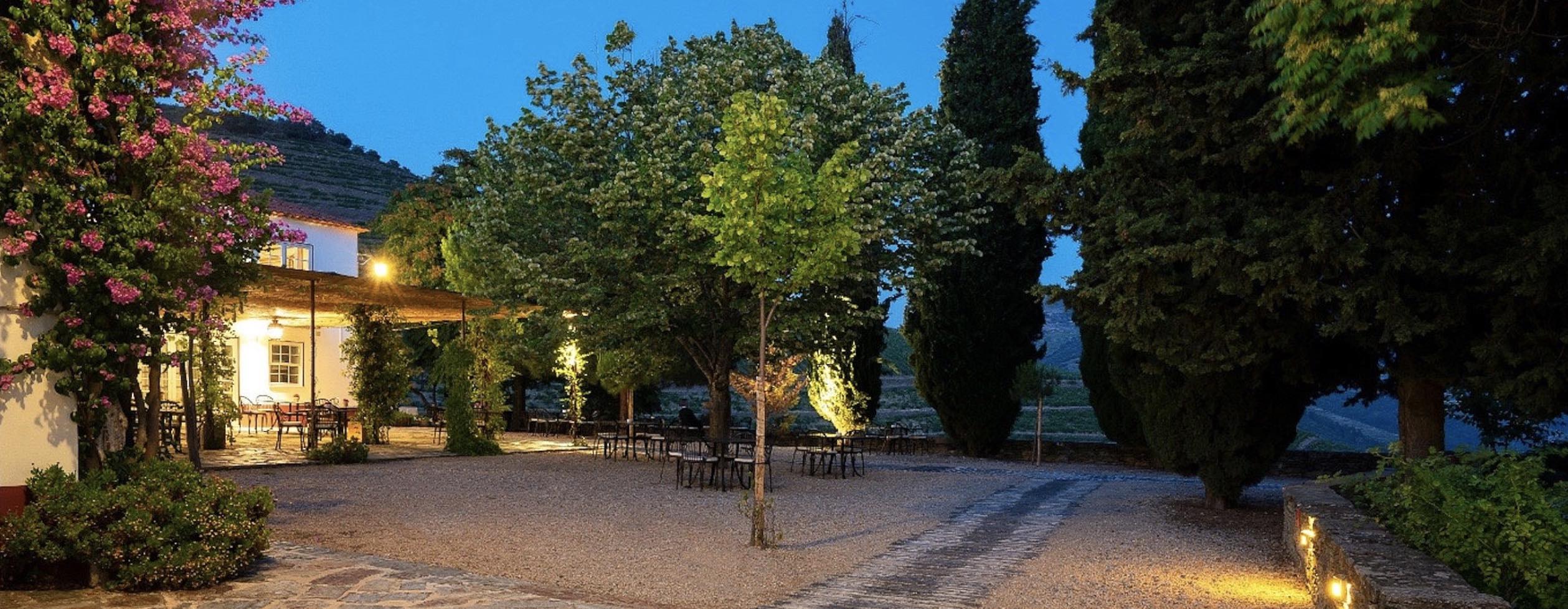
© Quinta Nova (read more about this winery and discover why it’s one of our favorites, below)
What are the grapes used in Port wine making?
The six grape varieties used for Porto wine
There are 198 native grape varieties in Portugal and, between these and those that have been imported and adapted through history, we produce many more. The Douro wine region privileges the use of traditional grape varietals, which do not only yield the type of characteristics the market has come to expect from Porto, but also contribute to the preservation of the local wine making traditions. As the shores of the Douro river are rather mountainous, not every type of grape could also grow to its full potential around here.
There are about 30 different types of grapes which are allowed to be used for Port wine making, according to the regulating authorities. But when it comes down to it, there are about 6 of them (we mean 6 red and 6 white) which are much more used than the others, as they are known to produce the best results. If more than 6 varieties are used, these main ones are generally still used in bigger proportions, with other varieties used in smaller proportions in the blend.
The main grape varieties used to make red Port wine are Touriga Nacional, Touriga Francesa, Touriga Francesa, Tinta Roriz, Tinta Barroca and Tinta Cão (which can also go by the name Tinto Cão). Touriga Nacional is one of the quintessential Portuguese grape varieties, known in Port wine making as well as in other intensely red wines. Touriga Nacional output usually translates in rather alcoholic wines, with robust tannins, and tremendous depth of flavor. Touriga Francesa, in its turn, is the most planted grape variety in the vineyards of the Douro region. It shares the same general characteristics as Touriga Nacional but with more subtle traces. The plant of Tina Roriz produces lots of fruit, which is obviously interesting from a commercial point of view. Tinta Barroca is appreciated because of its high sweetness and deep aroma, so mixing Tinta Roriz with Touriga Nacional and Touriga Francesa smoothes out the wine, resulting in a more balanced final product. Last but not least, Tinta Cão is one of the oldest grape types being produced in the Douro region so it’s the variety which is the most adapted to the local terroir. Tinta Cão usually grows quite successfully even in the least fertile of lands. Its fruit is small though, but it brings about a fresh acidity and velvety attributes which can greatly contribute to making extraordinary Port wine.
Is Port wine always red?
Not at all! This is actually one of the biggest misconceptions about Porto wine. Just like most table wines, Port can be red, white or even rosé.
 Rosé Port is made with the same grape varieties used for red Port wine making. In fact, all rosé wines are usually made with red grapes. So if red and rosé Port wines are made with the same grapes, how come they have a different color and flavor profile? The difference between red and rosé winemaking has to do with the first steps of the fermentation process. While red wine is prepared by fermenting red grape varieties with their skin on, rosé is initially made by pressing the same grapes with the skin on but the maceration process with the skin is way shorter. As for rosé the must is filtered after the initial pressing, the grape skins have way less time to release their color and affect the flavor of the wine. Overall, we could say that the skin of red grapes is given less of a chance to affect the grape juice and eventually result in a much lightly colored wine.
Rosé Port is made with the same grape varieties used for red Port wine making. In fact, all rosé wines are usually made with red grapes. So if red and rosé Port wines are made with the same grapes, how come they have a different color and flavor profile? The difference between red and rosé winemaking has to do with the first steps of the fermentation process. While red wine is prepared by fermenting red grape varieties with their skin on, rosé is initially made by pressing the same grapes with the skin on but the maceration process with the skin is way shorter. As for rosé the must is filtered after the initial pressing, the grape skins have way less time to release their color and affect the flavor of the wine. Overall, we could say that the skin of red grapes is given less of a chance to affect the grape juice and eventually result in a much lightly colored wine.
White Port wine tends to be fruity, smooth and aromatic. Thanks to the aging process, it often has a honey lingering sensation on the palate and wood undertones. If the vineyards of the Douro valley are planted in terraces on the shores of the river, the white grape varieties tend to be planted on the higher terraces. The most used grape varieties for white Porto include Gouveio, Malvasia Fina, Rabigato, Viosinho and Moscatel Galego. Gouveio is a resistant grape variety essential for white Port making, as it persists even when there are rains later in the season – something which can easily happen in the region of Douro. Malvasia Fina grapes present a yellow almost amber color and their flavor is rather fresh and not too complex. Rabigato is one of the most celebrated white grape varieties for Port making, as it offers very balanced acidity, good minerality and delightful aromas such as those reminiscent of acacia tree and orange blossoms. Viosinho is the kind of grape which reminds us that the Douro extends until the northern mountainous Portuguese region of Trás-os-Montes, as this is indeed a transmontana native grape. Viosinho grapes contribute to highly alcoholic wines, with a good balance between sweetness and acidity. Don’t be surprised to see Moscatel Galego (Muscat) as one of the grape varieties used for Port wine. While indeed this is the grape behind another of Portugal’s favorite fortified wines, Moscatel, it can also be used in Port wine making, blended along with other grape varieties.
Why is Porto wine sweet?
As we have briefly mentioned above, Port wine is sweet thanks to the fortification process. Just like when making any other wine, the initial steps to make Port wine involve harvesting the grapes and pressing them to extract the juice. This juice is to be fermented to turn the natural sugars of the grapes into alcohol – this is how wine is generally produced.
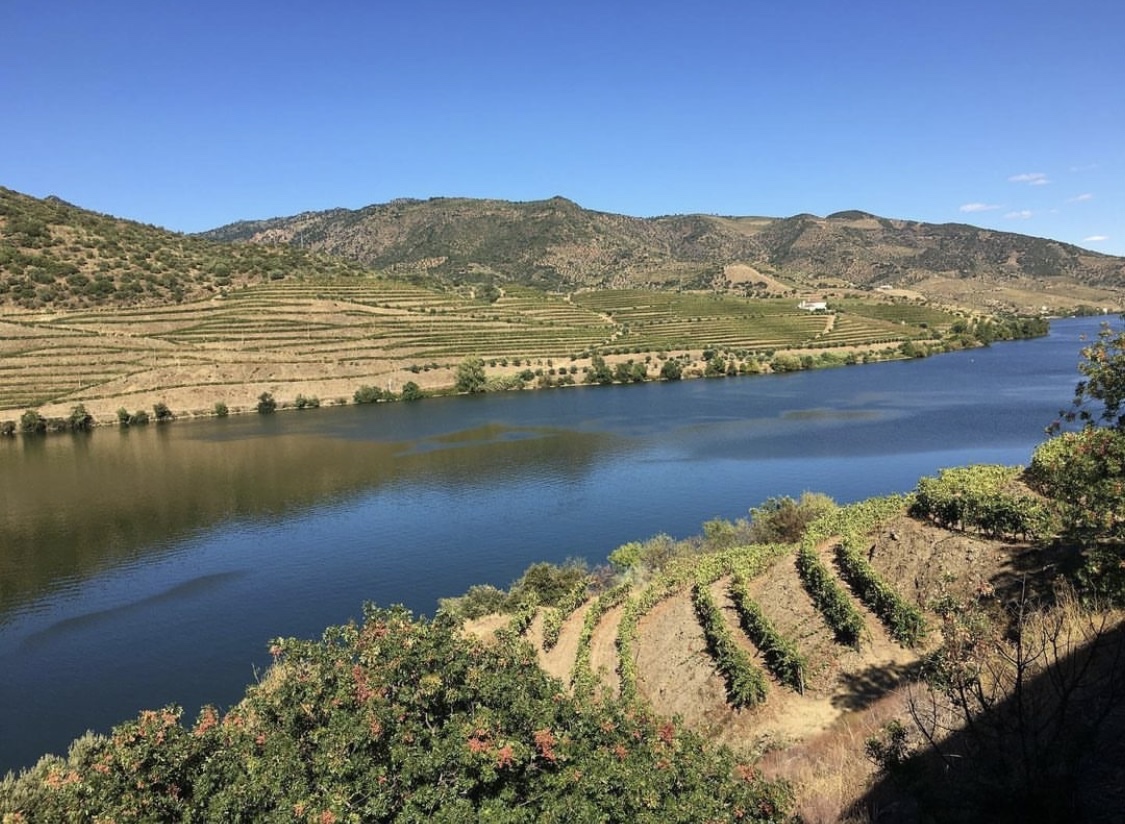
View from the regular public train – check below for more info (©Silvia Olivença, August 2020)
To make Port wine, at some point during the fermentation process winemakers add a distilled spirit, usually flavorless brandy (as neutral as possible as not to impact the final taste of Port), to interfere with the fermentation process. The naturally present sugars from the grapes aren’t all turned into alcohol, thus the end result includes more residual sugar, consequently Port ends up being a sweet wine.
But this doesn’t mean that all Port wine is super sweet.
There are different types of Ports according to sugar content, and which could be classified as follows:
– Extra dry Porto wine: up to 40 grams of sugar per liter
– Dry Porto wine: from from 40 to 65 grams of sugar per liter
– Medium dry Porto wine: above 65 and up to 90 grams per liter
– Sweet Porto wine: from 90 to 130 grams per liter
– Very sweet Porto wine: over 130 grams per liter
Certain varieties of Port wine are also aged inside wood barrels, a process which can also contribute to its sweetness. As time goes by, the wine absorbs certain wooden aromas and some of those have sweet tones, such as those reminiscent of vanilla, chocolate and caramel. This won’t certainly contribute to the sweetness of Port wine as much as the fortification process, but it’s something that shouldn’t be overlooked either, specially in varieties of Port wine that are left to age for longer periods of time, even decades, as during extended lengths of time the liquid will certainly develop peculiar aromas directly linked with the barrel where it’s being aged inside.
The types of Port wine
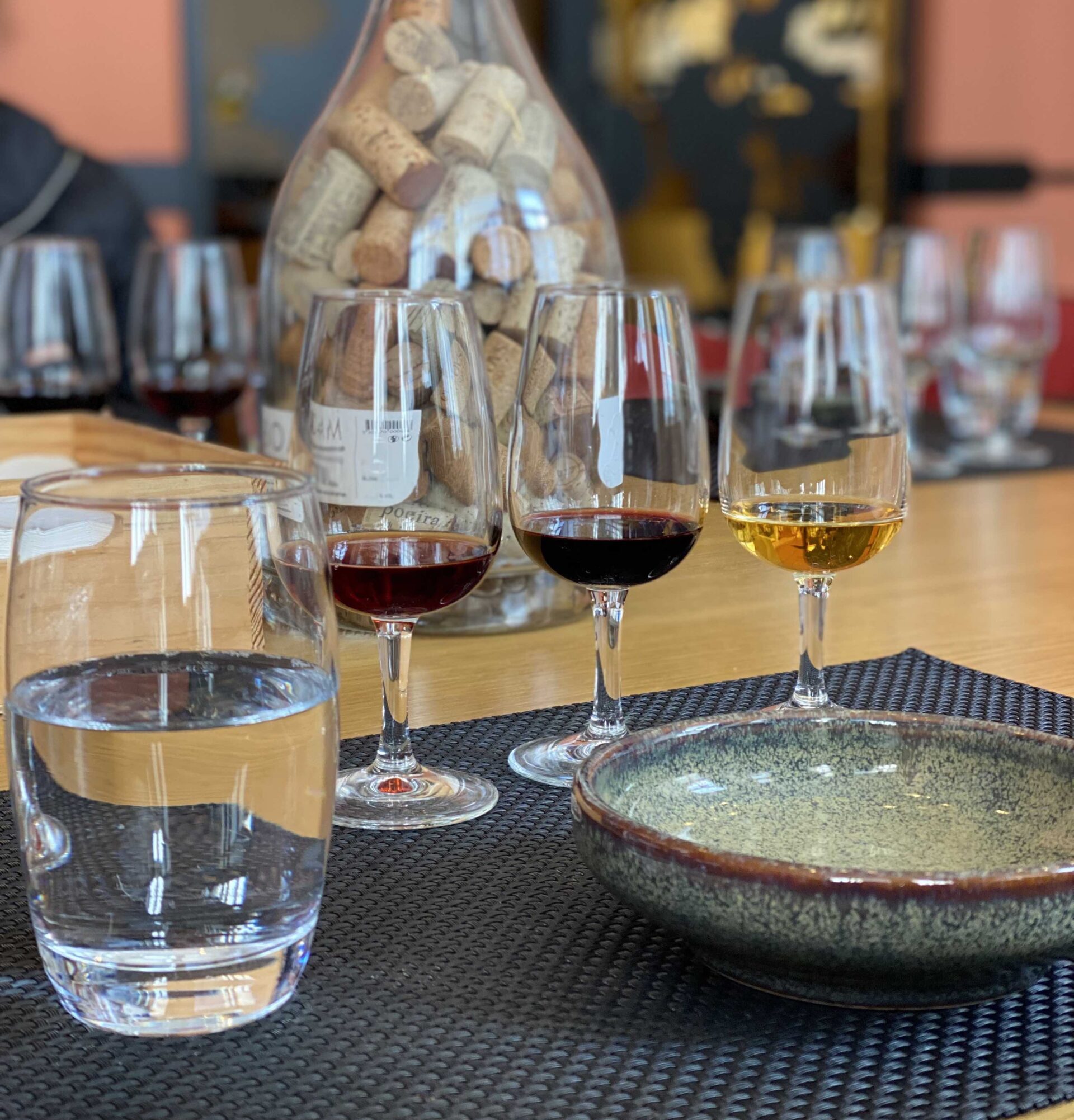
Porto wine tasting with Taste of Porto (© Silvia Olivença, December 2022)
These are different types of Port wine, which can be classified according to methods of production, the aging process of the wine and its overall style.
Red Port wine can be classified as Ruby or Tawny. The bright appearance of Ruby Port is responsible for naming the youngest type of Porto which is usually also the most affordable. Ruby Port is generally aged for about 2 years in large oak barrels and it can be consumed as soon as it’s bottled. Ruby Port is indeed meant to be enjoyed while still young – this is when you’ll be able to identify and relish on its usual flavors and aromas. Ruby Port is fresh and fruity, reminiscent of red berries, and best served slightly chilled (13-18C° or 55-65°F) for an uncomplicated wine tasting experience bound to please even those new to Port wine. Ruby Reserve (or Reserva, in Portuguese) involves a selection of Port wines from different years, blended to create a young, intense and versatile wine.
Within the category of Ruby Port we find the designations Crusted, Vintage and LBV, which stands for Late Bottled Vintage. Crusted Port is the lesser known variety of Ruby, standing for a rare variety of Port wine with a purple-black color and imposing depth of flavor. Crusted Port is bottled without filtration and spends at least 3 years aging inside the bottle before its release to the market. The name Crusted has to do with the crust of sediments which gather at the bottom of the bottle, once the wine forgoes sieving.
The naming Vintage can be misleading for those who aren’t aware of how Port wine is officially classified. While vintage literally means “of age”, in the world of wines it stands for the year in which a specific wine of high quality was produced. Vintage can safely be associated with outstanding Port wine. A Vintage year is one declared as such for yielding exceptional grapes which will translate into first-rate Port wine. This only happens an average of 3 times every decade. When you purchase a bottle of Vintage Port, it will always mention the year it refers to. Being within the Ruby category, Vintage Port is bottled early (between 18 to 36 months after harvest) and can be aged in the bottle. Late Bottled Vintage, on its turn, is also a single year vintage Ruby Port, but it may be aged inside a barrel for up to 6 years, before it’s bottled and made available in the market. As compared to young Ruby Ports, Vintage and LBVs are more full-bodied and nuanced. They aren’t usually filtered and, as they age inside the bottle, it is natural for them to develop sediment. If you open a bottle of Vintage or Late Bottled Vintage, you may need to decant the wine before proceeding with the tasting experience.
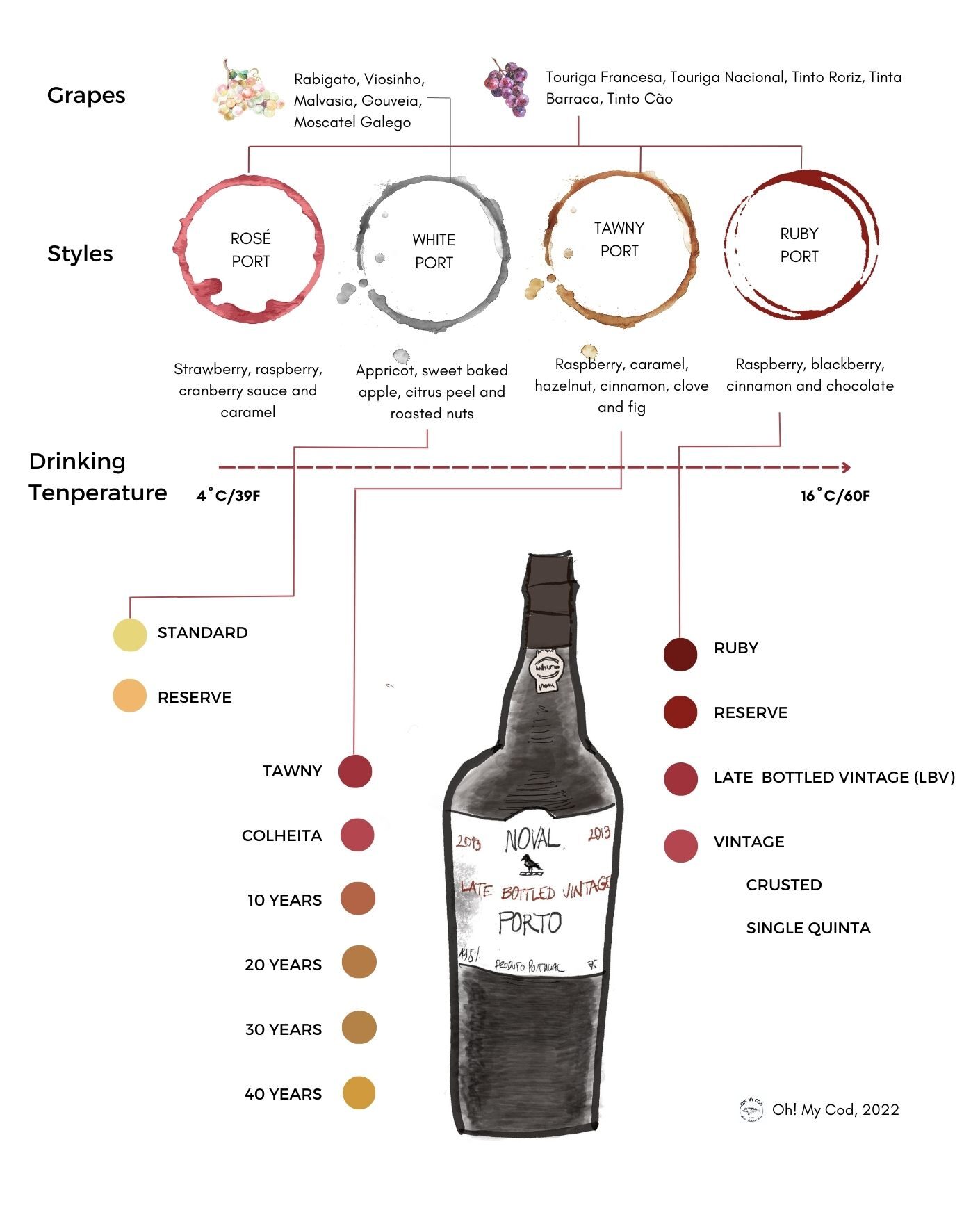 Tawny Ports tend to be more complex than young Ruby Ports. They are not as fresh nor fruity, but in turn delivery a more smooth aftertaste. Tawny Port is aged for at least 7 years in oak barrels, a time during which the wine takes on a slightly oxidized flavor (and color!) which is much praised. Tawny is more concentrated, rich and slightly sweet and, over all, we could say it has a more serious profile than younger Port. Tawny wine has notes of nuts and caramel, spices and grown-up candies such as toffee and brûléed custard. A bottle of Tawny Port will usually indicate the age of the wine, such as Reserve or Reserva (aged for at least 6 years), Tawny 10 Years (more evolved than the entry-level Tawny), Tawny 20 Years (more concentrated and with greater intensity of aroma), Tawny 30 Years (with gradual exposure to oxygen which concentrates and intensifies aromas and flavors even more), Tawny 40 Years (with complexity and persistence in the palate), Tawny 50 Years (a delicious elegant wine), up to Very Very Old (also known as VVO or W, standing for Port wines 80 years and older). Once open, a bottle of Tawny will last longer than a Ruby, remaining in optimal conditions for about a month, as long as kept inside the fridge. Enjoy Tawny Port at around 13-16°C or 55-60°F.
Tawny Ports tend to be more complex than young Ruby Ports. They are not as fresh nor fruity, but in turn delivery a more smooth aftertaste. Tawny Port is aged for at least 7 years in oak barrels, a time during which the wine takes on a slightly oxidized flavor (and color!) which is much praised. Tawny is more concentrated, rich and slightly sweet and, over all, we could say it has a more serious profile than younger Port. Tawny wine has notes of nuts and caramel, spices and grown-up candies such as toffee and brûléed custard. A bottle of Tawny Port will usually indicate the age of the wine, such as Reserve or Reserva (aged for at least 6 years), Tawny 10 Years (more evolved than the entry-level Tawny), Tawny 20 Years (more concentrated and with greater intensity of aroma), Tawny 30 Years (with gradual exposure to oxygen which concentrates and intensifies aromas and flavors even more), Tawny 40 Years (with complexity and persistence in the palate), Tawny 50 Years (a delicious elegant wine), up to Very Very Old (also known as VVO or W, standing for Port wines 80 years and older). Once open, a bottle of Tawny will last longer than a Ruby, remaining in optimal conditions for about a month, as long as kept inside the fridge. Enjoy Tawny Port at around 13-16°C or 55-60°F.
White Port categorization is different from red Port wine. There are no Rubys, Tawnys, Vintage or LBVs in the world of white Port. White Port is usually classified based on its level of sweetness: extra-dry (extra-seco), dry (seco), and sweet (doce). Younger white Ports are usually enjoyed as an aperitif or in cocktail making, while aged white Ports would pair best with desserts and cheese platters. Lágrima (meaning ‘tears’ in Portuguese) is the sweetest style of white Port. It’s characterized by fresh acidity but also notes of nuts, honey and caramel. Just like red Porto, white Port can also be classified according to age. Labels of white Porto will read 10 Years, 20 Years, 30 Years, 40 Years and 50 Years, while the more entry-level younger Porto is classified as Reserve. While the previous categories stand for white Ports made with blends of grapes from several years, Colheita white Ports include only grapes harvested within one single year.
Rosé Port is the least explored type of Porto, in Portugal and abroad. Even though rosé Port is more unknown, it has been gaining popularity in recent years. Rosés are the most vibrant of all Port wines. They should be served chilled, between 8-10ºC (that is 46-50ºF) and it’s not unheard of to serve them with ice. There are no sub-categories of Porto rosé, at least for now. This is a more recent variety of Port and the first ever rosé Port was Pink Croft, by renowned Port wine brand Croft. Rosé Port is fermented in a cool environment to preserve the fruity aromas and fresh character of the wine.
How much does Port wine cost?
Port wine price can be highly variable, depending on the type of Port wine in question, for how long it’s been aged and even according to the year(s) during which the grape harvest and the wine making process took place.
The most expensive Port wine ever sold had a price tag of 8900 euros, and it was a Nacional Vintage Port from 1962, by Quinta do Noval. Jealous you didn’t get that bottle? Don’t be! At this very moment you could hop online and purchase a tawny Port wine for over 5000 euros right here.
Port wine price doesn’t of course have to be this steep for you to be able to enjoy a very good drink. You could get a Ruby Porto at any given Portuguese wine store or even supermarket for easily less than 10 euros. About the same budget may not buy you the best Tawny Porto, but it will grant you access to very decent options. To indulge in a Vintage Port wine, you will indeed need to increase your budget to at least 40 to 50 euros though. But many would argue this is worth the splurge!
How to do a Douro Valley day trip from Porto

Taylors cellar
There is no shortage of tour operators organizing visits to Douro Valley vineyards as a day trip or even a multi day trip from Porto. But, if you like traveling independently, know that it is very doable to do such an excursion by yourself.
Vila Nova de Gaia Porto wine cellars
If you are basing yourself in the general Porto area, we’d recommend starting by visiting the cellars across the river, in the city of Vila Nova de Gaia. Because of urban planning, financial and even climate related reasons, this is where Port wine is usually aged and stored and, when you’re in downtown Porto by the riverside, there’s no way you’ll miss the big brand names over iconic buildings in Gaia. Such cellars are usually open to the public and some of them even offer quick free guided visits with tastings. Of course having a little budget at your disposal will grant you the opportunity to taste more than the entry level Ports which, considering you came all the way here to discover, we think are very worth exploring – on their own or, why not, with a nice platter of cheese and charcuterie to get your juices flowing.
Oh! My Cod Porto wine cellars selection
To reach the Port wine cellars and warehouses of Gaia you can literally walk from central Porto. Crossing the Dom Luís I bridge on foot is literally a 10 minute affair and it is so worth it to soak in the wonderful views all around, not to mention the bridge itself is a UNESCO World Heritage Site.
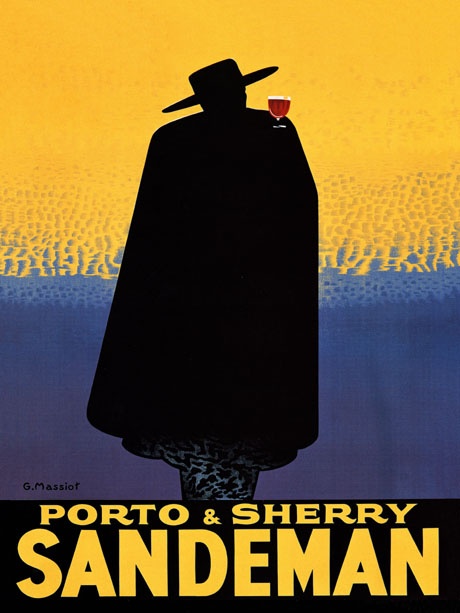 Once in Gaia, some of the best Port wine cellars we’d recommend checking out include brands such as the more than 3 century old Taylor’s (Rua do Choupelo 250), which offers guided visits with audio guide, premium tastings of Port Taylor wine, and even full-on masterclasses for those seriously looking into taking their Port wine game to the next level. At Ferreira (Av. de Ramos Pinto 70) you will not only be able to learn about Port wine per se, but also plenty about the history and customs of this area. This brand celebrates not only the drink but the people who have historically contributed to making Port such an icon of the Douro. Whatever you do, don’t leave Ferreira’s caves without trying Dona Antónia Reserva Tawny. Real Companhia Velha (Rua Azevedo Magalhães 314), one of Portugal’s oldest national wine companies, founded back in 1756, should be visited by those who take Port wine solemnly. They offer different types of experiences, depending on your budget. If your pocket allows, head to Graham’s (Rua do Agro 141), tour their wine cellar and treat yourself at Vinum, their very own restaurant and wine bar. Other Port wines whose cellars it would be worth checking out in Gaia include Ramos Pinto (Av. de Ramos Pinto 380), Cálem (Av. de Diogo Leite 344), Burmester (Largo Dom Luís I) and Sandeman (Largo Miguel Bombarda 3), where you shouldn’t overlook the acclaimed Sandeman Ruby Port and Sandeman Founder’s Reserve.
Once in Gaia, some of the best Port wine cellars we’d recommend checking out include brands such as the more than 3 century old Taylor’s (Rua do Choupelo 250), which offers guided visits with audio guide, premium tastings of Port Taylor wine, and even full-on masterclasses for those seriously looking into taking their Port wine game to the next level. At Ferreira (Av. de Ramos Pinto 70) you will not only be able to learn about Port wine per se, but also plenty about the history and customs of this area. This brand celebrates not only the drink but the people who have historically contributed to making Port such an icon of the Douro. Whatever you do, don’t leave Ferreira’s caves without trying Dona Antónia Reserva Tawny. Real Companhia Velha (Rua Azevedo Magalhães 314), one of Portugal’s oldest national wine companies, founded back in 1756, should be visited by those who take Port wine solemnly. They offer different types of experiences, depending on your budget. If your pocket allows, head to Graham’s (Rua do Agro 141), tour their wine cellar and treat yourself at Vinum, their very own restaurant and wine bar. Other Port wines whose cellars it would be worth checking out in Gaia include Ramos Pinto (Av. de Ramos Pinto 380), Cálem (Av. de Diogo Leite 344), Burmester (Largo Dom Luís I) and Sandeman (Largo Miguel Bombarda 3), where you shouldn’t overlook the acclaimed Sandeman Ruby Port and Sandeman Founder’s Reserve.
While visiting some of Gaia’s oldest cellars, you may notice some big sized metal grids by their gates. So what are these for? These grids were installed to protect barrels of Port wine in the event of a flood. To be more precise, the grids are meant to prevent barrels from rolling around and getting mixed if a flood was to happen, something that was more of a possibility before 1971, prior to the Douro river being dammed. Even though back then the waterflow in the river could more easily get out of control eventually rushing past the terraces on both its shores, now-a-days, this type of phenomena is much more under control.
If this introduction to Port wine in Gaia hasn’t proved as fruitful as you’d want it to for the sake of context, you can also visit the Port Wine Museum (Rua de Monchique, 45-52) in the city of Porto itself. During the week the access ticket costs little over 2 euros, while during the weekend it is actually free! This is a decent place not only to learn about the history of Port wine, but also to grasp more about the impact that this industry has had for the local development, economically, socially and even culturally.

This train, that seems taken from a Wes Anderson movie is our ‘coup de coeur’. (©Silvia Olivença, August, 2020)
Douro Valley wineries
Douro valley road trip
Now that we’re past the introductions, let’s look into the more fun part of this journey: traveling and exploring the Douro region! If you have your own car, we recommend scribbling a tentative route, according to the Douro Valley vineyards you’d like to visit the most – see our suggestions above. Road tripping along the Douro Valley is a delight, particularly during the summer, just before the wine harvest period at the end of the warmer months happens, as this is when vineyards are full of fruits and the landscape looks the richest. But, even during any other time of the year, the scenery is spectacular and, of course, there are always good wines to taste during the journey.
Douro valley by boat or train
If you are relying on public transportation, it is still not that hard to explore the Douro Valley. In fact, if you are actually not driving, you will be able to taste as many wines as you’d like without worrying about getting behind the wheel. Taking the beautiful vintage train from downtown Porto to Peso da Régua is probably the easiest way to start your exploration of the Douro region and the train ride in itself already has tremendous potential to be captivating – more information and train schedule here. For the price of a regular train ticket, this Douro Historical train trip, running from July to October, offers you stunning views and perspectives, sometimes just a few meters/feets from Douro river.
There are also different boat cruises departing from Peso da Régua, usually offering trips between 1 to 8 hours. As you float down the Douro river, you will get to enjoy a privileged view of the surrounding vineyards planted on the terraces on the shore, which actually those driving don’t get see the same way. Even though these are touristic boats, they do the same route the commercial boats carrying wine from along the valley to Porto and Gaia would do, so there’s certainly a historic sense in this trip, it isn’t mere sightseeing.
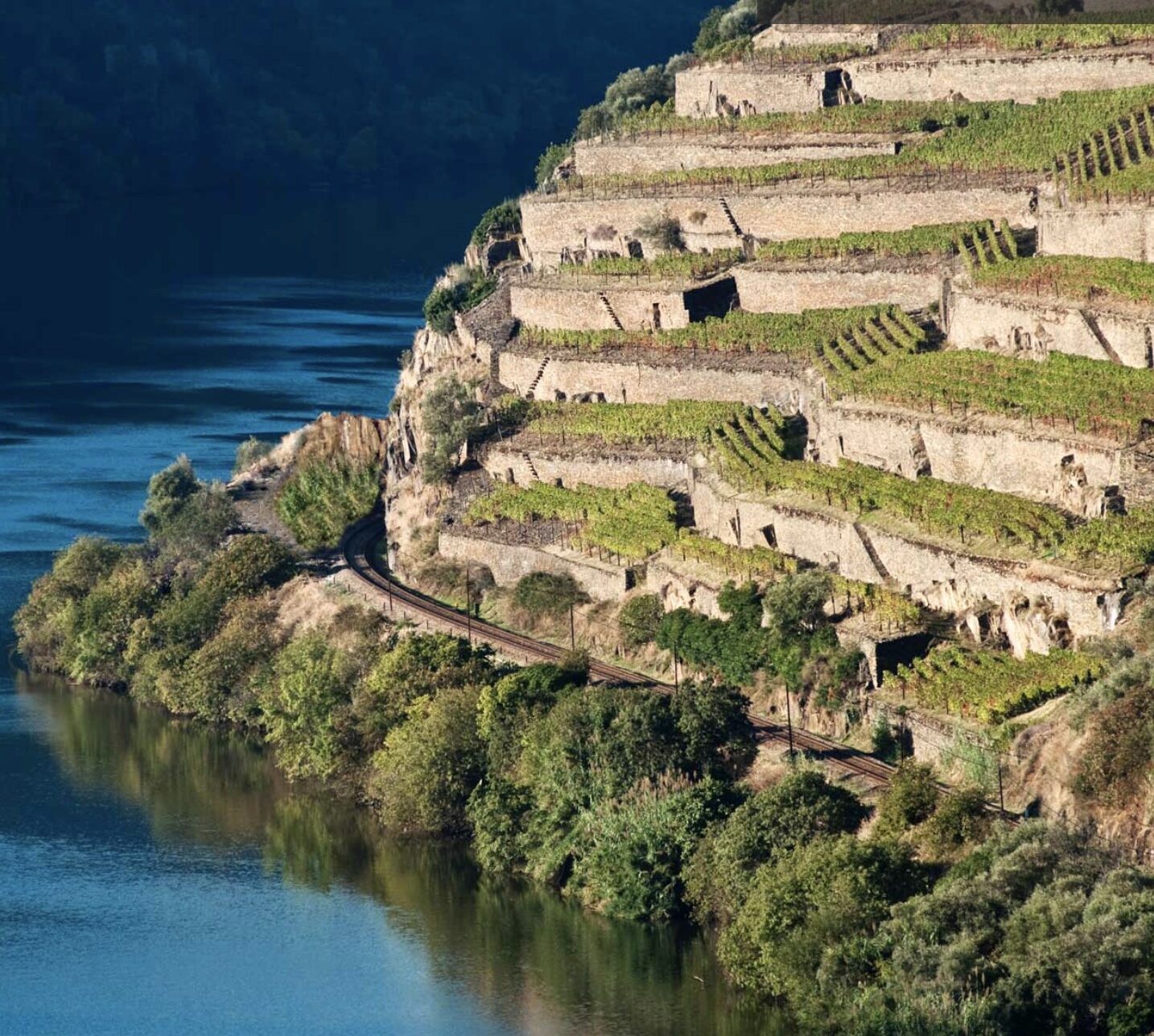
Rails of Douro historical train but also where the sophisticated Presidential train passes by
Most folks would settle for a boat ride of a couple of hours at most, to enjoy the scenery and, once back on land, go explore one or more vineyards of their preference. Of course you will be somehow limited once you don’t have a car here and as we’re talking about a series of small village and towns along the 130 Km (80 miles) which extend between Pinhão (where many of the smaller boat tours starting in Peso da Régua end) and back to Porto, you shouldn’t count on regular bus service.
The good news is that in Pinhão itself, you can soak up a lot of the essence of the Douro just by walking around. You can walk up to the scenic viewpoints to admire the vistas, but you can also go wine tasting at vineyards such as Sandeman’s Quinta do Seixo (Valença do Douro, Tabuaço) or Quinta do Bonfim (Largo do Videira, Pinhão). Because with good wine comes good food (or should it be the other way around?), do not overlook the typical dishes of this region. Some of the must-try typical foods in Porto and the Douro area include the iconic Portuguese boiled dinner cozido à portuguesa, roasted goatling, several sal cod fishes, and more.
If you’d like to stay overnight here, there are different types of accommodations, ranging from hostels to mostly fairly fancy wine hotels, so that you can sleep off the wine and continue exploring or going back with your energy recharge on the following day.
The presidential train
If your budget truly allows and you have time to spare and the desire to somehow travel back in time in the most sophisticated and regal of ways available around here, look into booking tickets for The Presidential. This was a train back in the day used by the royal family and later on heads of state and important personalities, which is now-a-days used to do high-end tours along the Douro Valley. They usually offer a full day program, even though sometimes also host overnight trips, across 2 to 3 days. Everything that happens abroad at The Presidential is top notch quality (you are certainly paying for it!), including multi course meals prepared by some of Porto and Douro’s top chefs, and highly curated wine pairings. The Presidential does stop at selected spots along the region, namely to do what most come here to do: visit vineyards and try different Port wines. On board there is no dull moment, as you’ll get to indulge into gastronomic experiences and be entertained by a varities program.
Best wineries in the Douro Valley you should visit
There is no better place to enjoy Douro wine than, well… in the Douro itself! The journey from Porto to Douro Valley is very doable even as a day trip, so don’t miss out on the opportunity when you are visiting the region. There’s no doubt that sipping Port wine as your view extends along the terraces full of vineyards has the potential to make your wine tasting much more complete, not only by providing a sense of place, but also a certain dash of romanticism.

© Quinta do Vallado
The best wines in Douro Valley can be hard to pinpoint, because there is a high concentration of vineyards in this region and, thanks to tight controls, they all offer above average drinks and experiences to those lucky to visit. You can simply tour the vineyards and sign up for a wine tasting session. Or, depending on the venue, you may want to do a meal, a workshop, a harvest experience or, because opportunities certainly abound in the region, even spend the night at an alluring hotel at a winery.
You will notice that most wineries have the word quinta in their name, as this is the Portuguese designation for estate. In many of these quintas you will of course be able to taste fortified Port wine, but also other incredible Douro table wines. If you play your cards right, these can be enjoyed with remarkable local cuisine, ranging from traditional to more contemporary. For the sake of our topic here today, Porto, we are focusing on the best wineries to do Port wine tasting experiences.
Quinta da Pacheca (Rua do Relógio do Sol 261, Lamego) is one of the most celebrated wine estates in Douro. It offers accommodation inside wine barrels (large sized ones, of course) and these have tremendously contributed to the marketing of this wine estate. Quirky accommodations aside, Quinta da Pacheca organizes guided visits to the vineyards and cellars where the wine is produced, as well as gastronomic experiences such as a picnic in their beautiful vineyards. During wine harvest season, go all in and book yourself a full day experience which includes breakfast, grape picking and storing at the warehouse where the winemakers will do their magic, brunch and, of course, a rather complete wine tasting season. Without prior experience, this is as close as you may get around here to feel like a winemaker for a day!
Quinta Nova da Nossa Senhora do Carmo (5085-222 Covas do Douro) is one of our top choices, because this is the kind of place that has managed to retain the essence of Douro yet rejecting opulence in favor of a certain simplicity that, to us, speaks of its authenticity. This estate has 11 rooms which guests can book and that are a part of the elevated Relais & Châteaux hotel brand. It is also a spectacular venue to get married at, for those who can afford it. The views all around are literally breathtaking and everything they do at Quinta Nova da Nossa Senhora do Carmo matches this: the food is absolutely impeccable and so are the wine pairings they do, with their own brand as well as with labels from oher wine estates in the area.
Quinta do Vallado‘s winery (Vilarinho dos Freires, Peso da Régua) runs daily wine tastings, conducted both in English and Portuguese. For those seeking a good intro to Port wine and a small tasting without having to embark in a big or expensive production, these experiences of little over 1 hour are ideal. Of course if you’d like to do something more in depth, Quinta do Vallado also offers customizable tours and workshops upon request. One of the most unique Portos at Quinta do Vallado is Vallado ABF, with Port wine produced in 1888, with a limited edition of 933 numbered bottles. As connoisseurs will be able to anticipate, Vallado ABF’s aroma is remarkable, evocative of mahogany, dried fruits and spices, with complex and deep taste thanks to its age. If you can afford this 3450 euros bottle of Port, there may not be a better place to sip it mindfully than right here at Quinta do Vallado, overlooking the slopes down to the Douro river.
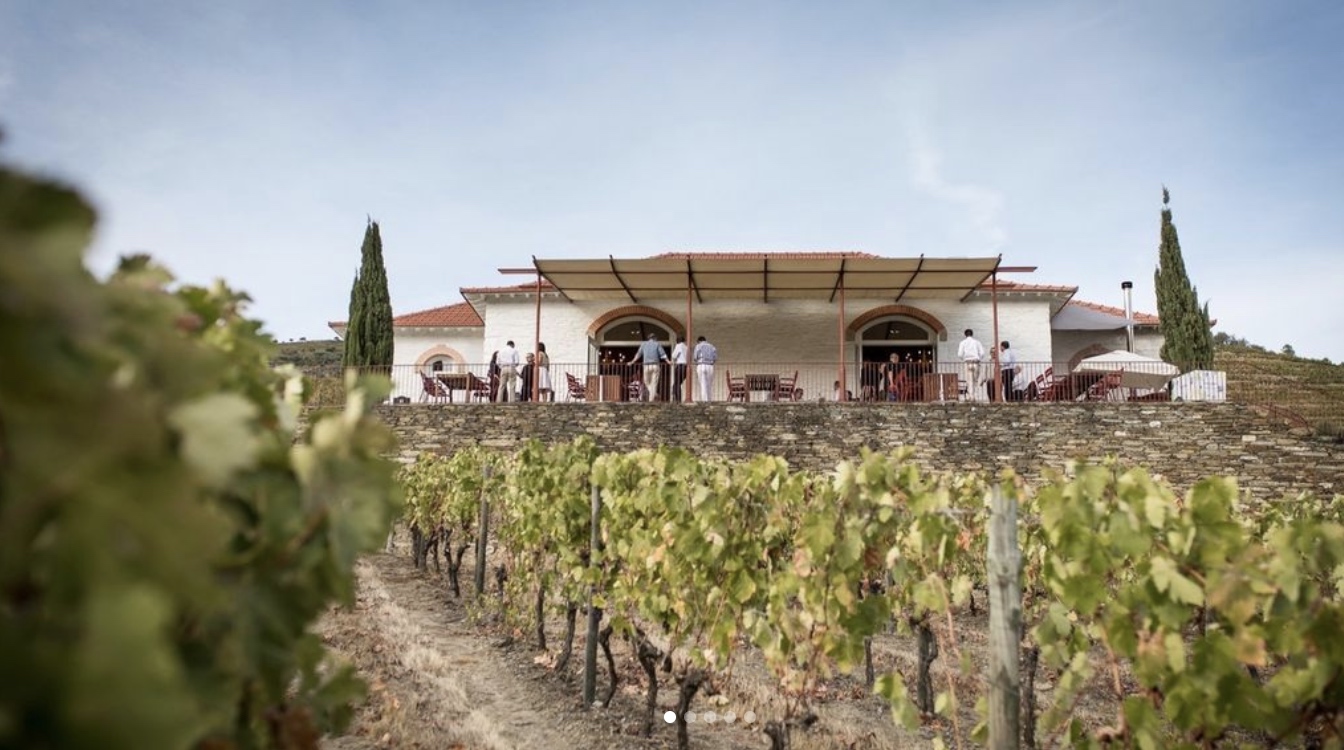
Pop-up restaurant at Quinta do Bomfim in partnership with Chef Pedro Lemos (© Symington Family Estates)
At Quinta do Portal (EN 323, Celeirós), besides the more commonplace Port wine tasting experiences, if you gather a group of at least 8 people, you can have a rather peculiar experience, during which you will be allowed and guided to make your own blend of Port wine. You could mix distinct grape varieties in different proportions and taste a Port wine like no other available in the market!
If you travel to Pinhão on a day trip to the Douro Valley as we suggest above, simply using public transportation, you’ll be happy to know that Quinta do Bonfim (Largo do Videira, Pinhão) is just 5 minutes walking from the train station. You can leisurely walk around their vineyards for as little as 5 euros and one of the things we like about Quinta do Bomfim is that they offer quite a wide range of tasting experiences, so that you can get to join independently of your budget. Even though the wine estate includes the restaurant Bomfim 1986 by chef Pedro Lemos (with a homonym Michelin starred restaurant in Porto), it still offers a fairly democratic welcome to its guests.

© Quinta de Ventozelo
Because not everything has to be particularly fancy or exclusive in Douro, allow us to also suggest a visit to Quinta do Ventozelo (Ervedosa do Douro, S. João da Pesqueira), which is all about no-frills, honest good food and wines. Set in an architecturally stunning property, surrounded by a lovely view (which can very much be enjoyed while you dip yourself in the pool), Quinta do Ventozelo sure knows how to keep its guests happy with delicate meals prepared with the highest quality ingredients from the area, including their own production of olive oil and even gin.
If you are looking for a smaller scale winery with a more independent feel, we’d suggest going to Quinta de la Rosa (EM590, Covas do Douro), which offers different visits and Port wine tasting sessions, starting at as little as 20 euros. While many other estates in the region produce a variety of wines, including fortified and table varieties, at de la Rosa the main focus does indeed go onwards Port wine. This is the type of place which still cares a great deal about traditional methods of production and the craftsmanship associated with those – we’re talking about manual harvests in the rocky slopes along the Douro valley, and the hardship that is behind every sip of this delightful nectar and, for the sake of full on appreciation, we believe should not be overlooked when you open a bottle. You can visit the estate of Quinta de la Rosa and also book yourself for a meal with wine pairing.
Smaller independent producers of Port wine could only be a reality after Portugal joined the European Union in 1987, when the new rules allowed smaller brands to export. Thanks to the EU open borders we can now enjoy the captivating wines of smaller-scale wineries which can be visited in the Douro, such as Quinta dos Murças (Covelinhas), with a mostly organic production; and Quinta do Castro (Gouvinhas, Sabrosa), which besides the winery itself includes a beautiful hotel and restaurant.
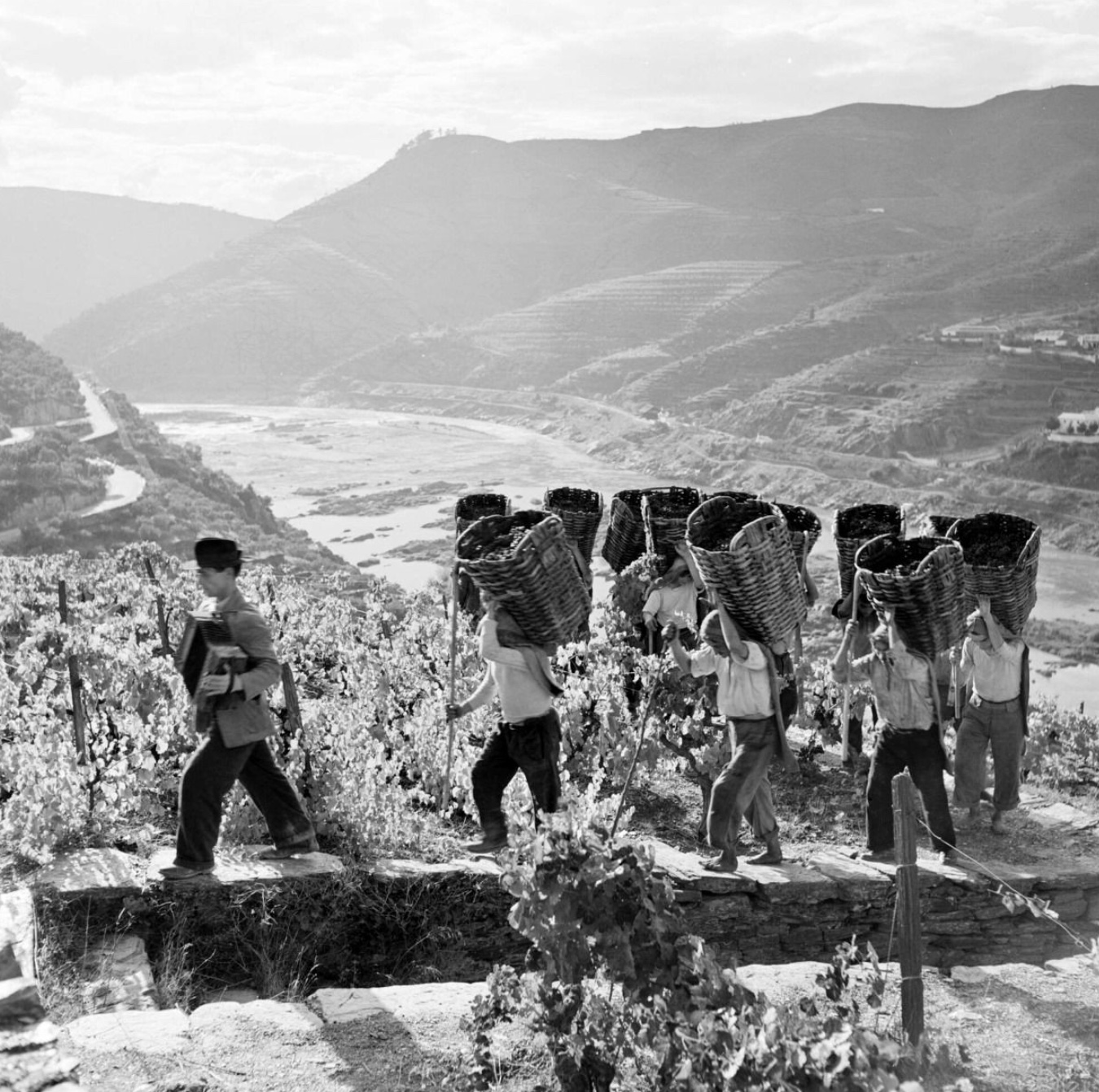
Porto wine harvest. Photo from our beloved Artur Pastor.
The dark side of Porto Wine
The regulation of the Port industry began in 1756 with Pombal’s demarcation of the Douro region and, as we have explored above, became more complex in more recent times, namely during the 20th century. During the fascist regime led by Salazar (1933-1974), in fact as early as 1933, a bureaucratic triad was created. This triad is, until today, responsible for the collateral damage which is associated with the Port wine industry.
The Instituto do Vinho do Porto (IVP, Institute of Port Wine), which regulates the production of Porto wine, the Casa do Douro, and the Grémio dos Exportadores de Vinho, to which all exporters of this wine have to belong to, make up a regulatory network which ultimate translates into countless restrictions. One of these restrictions has to do with the limitation of the production of Port wine, with the goal of curbing overproduction and over supply, thus also preventing price drops.
In this context, back in 1947, a rule called beneficio was introduced. Beneficio literally translates as benefit, which is rather ironic when we understand what this measure regulates, which is quite the opposite of something beneficial, at least not for those who should actually profit from it, as we are about to see. The beneficio, which was created by agronomist Alvaro Moreira who used to work for Salazar’s dictatorial government, decides the amount each winegrower can produce. This is decided depending on each vineyard’s classification, according to production potential. Of course all of Douro’s vineyards have different potential, according to the micro terroir associated with their exact location, taking into account factors such as altitude, the topography and particularly the steepness of the terrain where the vineyard is planted, sun exposure or shelter, but also grape varieties which are being grown there. As such, each vineyard is granted a license for a certain volume of Port production, which is renewed each year by the IVDP. Since the year it was created, almost a century ago, this system has not undergone any changes or updates whatsoever.
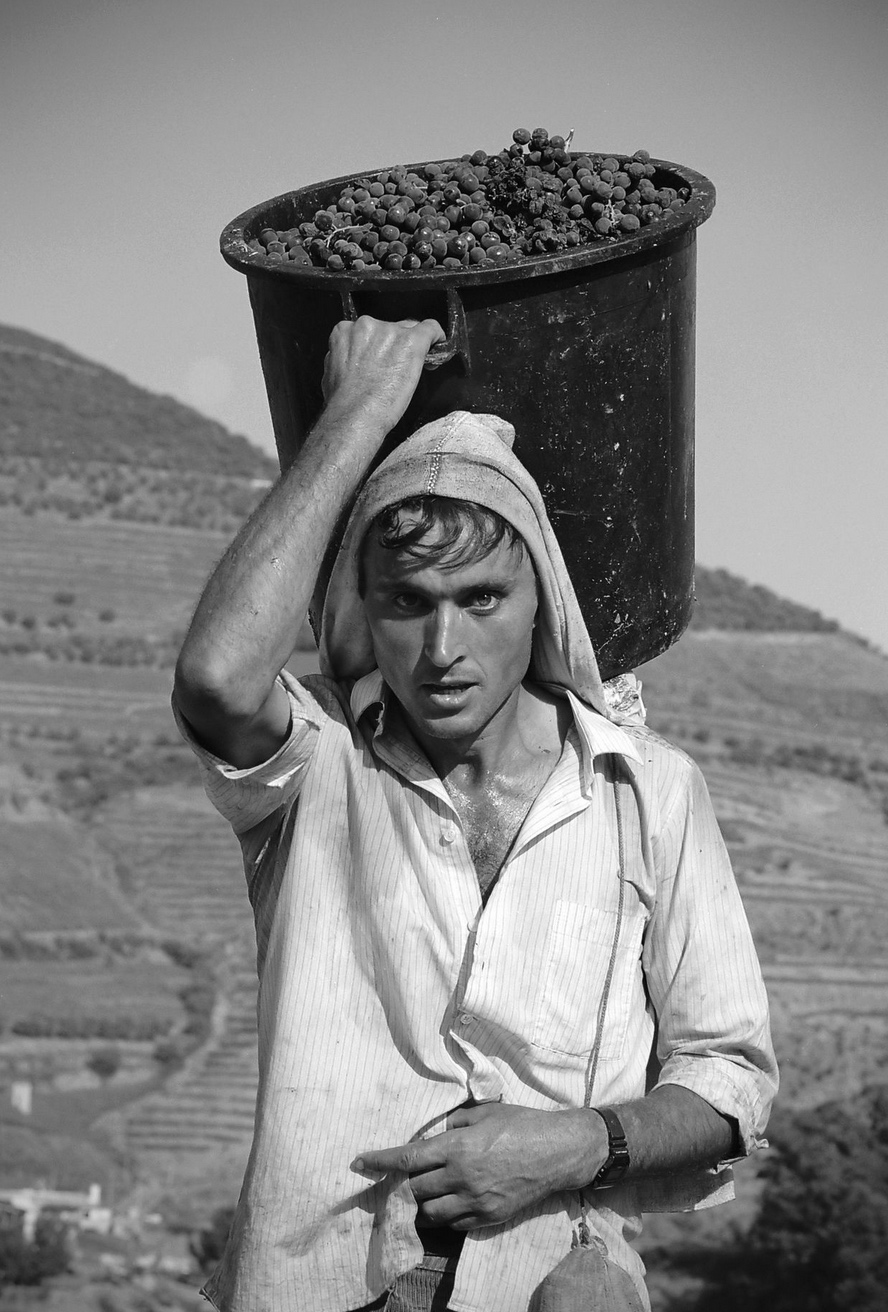
Pinhão, Douro, 1997 (© Alfredo Cunha)
So what happens to the grapes which have been grown beyond the limits granted to a given producer past his benefício quota? Most producers end up selling their “excess” grapes for the production of table wine, which is not limited by the benefício. They normally use the more premium grapes for Port and leave the lower grade ones for table wine making. But what ends up happening is that producers find themselves in a position in which they are forced to sell their “excess” grapes (and we do say excess in quotes as they are only seen as such because of all of this bureaucracy) below production price.
In a region of heroic wines, which in a way can be equated with Pico in the Azores, where there is no possibility of mechanization and where production costs are higher than most other regions across Portugal, these producers have been forced to sell their product at a humiliating price. Not only that, their grapes end up being used to produce table wine which, despite originating in such a unique terroir, ends up competing with wines which come from mechanized regions.
This situation has greatly contributed to the neglect and abandonment of vineyards in the Douro, namely old vines. Taking all of these regulations and limitations into consideration, some producers became uninterested in maintaining the vineyards and producing Port wine, and started selling their beneficio to other Port wine producers, yet without selling them their grapes. Those who purchase the document see their production quotas increased and keep producing on their estates, while the vineyards the beneficio belonged to in the first place tend to get abandoned. Moreover, it is known that some of the most renowned Port wine brands spend millions of euros buying additional beneficios. Considering that there are only 4 IVDP inspectors to control the entire Douro region, it is not difficult to escape control or argue that a given year granted exceptional production, thus justifying the mismatch between the beneficio and the actual yield!
We feel that all of this has contributed to the mischaracterization of the Douro wine region. In this unsustainable scenario, some Port wine producers such as Symington, have been rebelling against this system, which has remained unchanged since it was created in 1947.
The price of Port remains artificially high, while Douro table wines descend to mediocre prices and quality to match. Now-a-days, in terms of volume, the production of these Douro table wines is comparable to that of Port wine, when just a century ago it was practically non-existent.
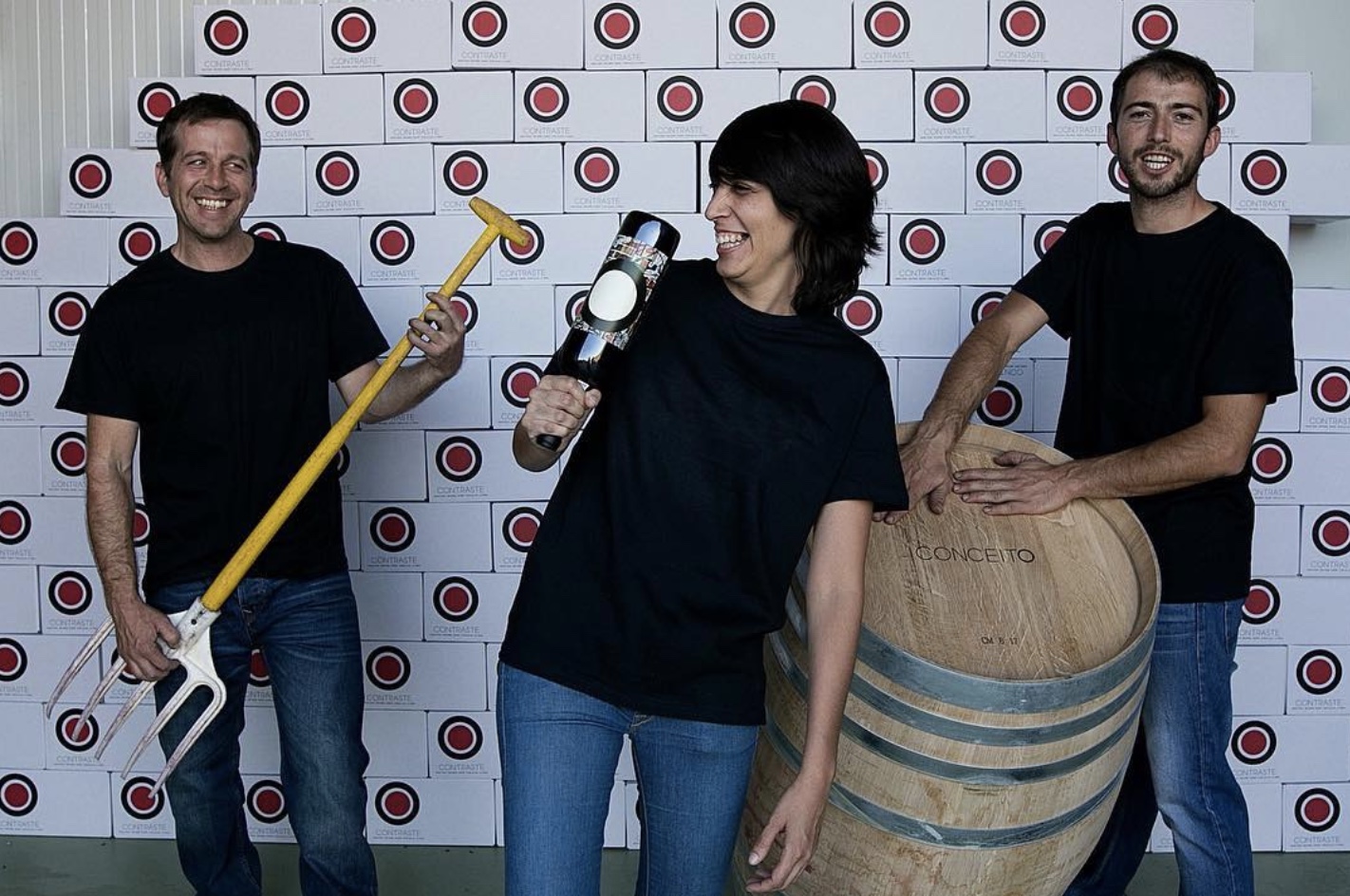
© Conceito wines
“There’s a Crack in Everything. That’s Where the Light Gets In”
The rise of Douro table wines
Invariably, in all social and cultural contexts where we witness a relationship of dominance, minorities tend to creatively come about, and so do subversive actions and discourses – see, once again, the history of Pico wine.
Faced with the overwhelming force of bureaucracy associated with the Port wine production industry, some producers have developed a healthy marginal position, which has allowed them to recover the dignity of Douro table wines but also of their vineyards and work.
Barca Velha was one of the pioneering producers that wanted to elevate Douro table wine. Their first harvest happened back in 1952 but, for many years after that, they were still treated with skepticism. Nowadays though, they have considerable prestige, producing wines which sell for hundreds of euros a bottle, after critics award them with high scores.

Prices of Barca Velha wine in June 2023 at Garrafeira Nacional (Lisbon)
Until the mid 1980s, Porto’s supremacy was ingrained into the minds of wine growers and distributors alike, with some exceptions such as Quinta do Infantado, which managed to break the monopoly of Port wine in 1979 with its own production and, more recently, with its most recent generation, ends up producing a million bottles of table wine a day.
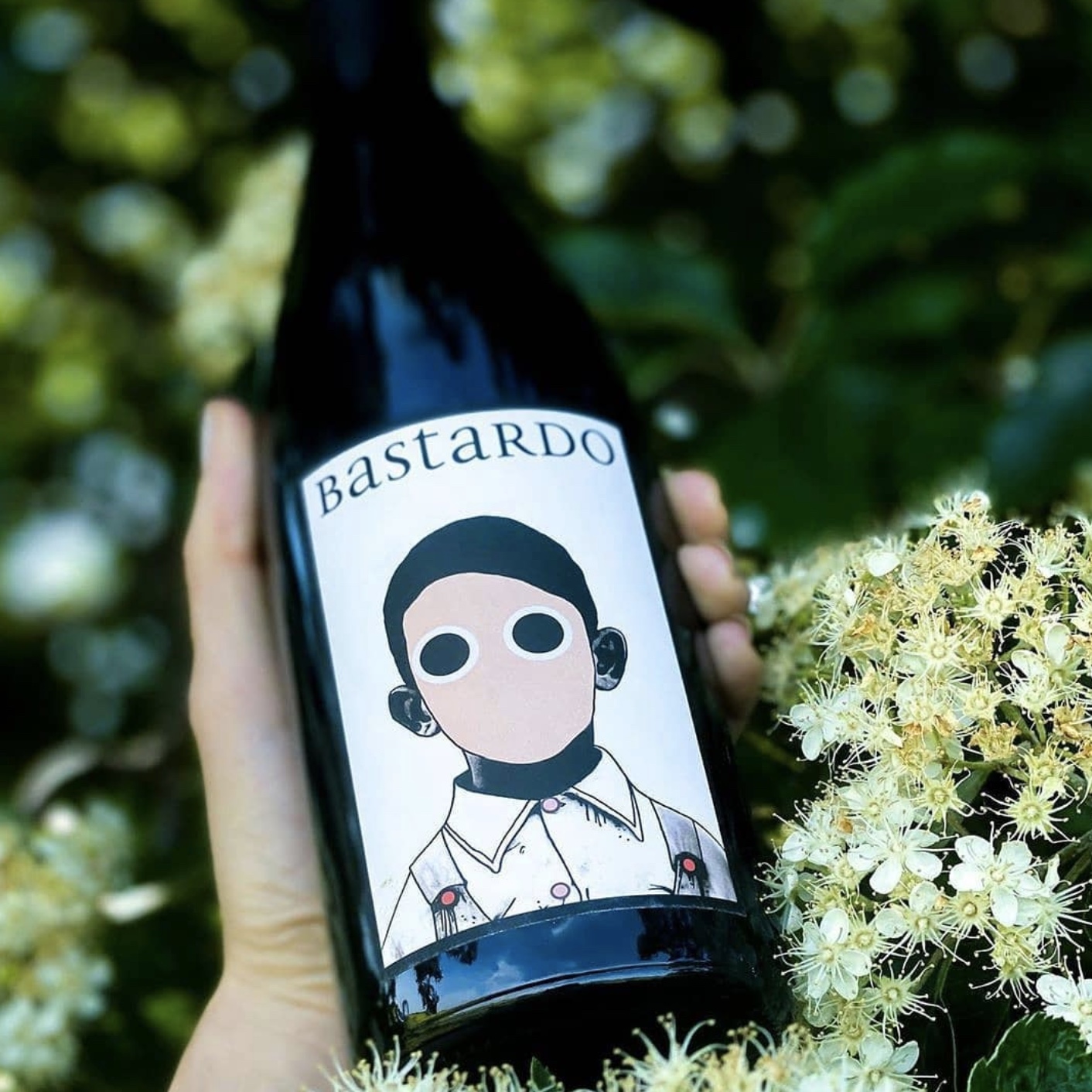
© Conceito Wines
However, during the 21st century, we’ve seen how Portuguese millennials, who are driven by passion and authenticity over commercial considerations, have elevated Douro table wine in a unique, respectful and sustainable way to the local terroir. The newer generation has been debunking preconceived ideas about Port wine, giving rise to adapted methods which make sense for table wines, and even including grape varietals considered of low quality for the production of Port wine. Some tend to prefer low-intervention wines. Some have been recovering old wine styles, old techniques and even ancient vineyards, which is for example what has been happening with Rita Marques, with Bastardo wine and Conceito wines. While others work with biodynamic viticulture, namely Mateus Nicolau de Almeida under the label Trans Douro Express and Muxugat. Tiago Sampaio, with the well-known Uivo wine, created his own style and the truth is that we could go on with examples that fill us with hope for the future of Douro table wines.
Thanks to human creativity and passion, the benefício gave rise to table wines in a region where they were virtually non-existent. If initially these table wines were just a by product of surplus, without their own identity as such, today they are some of the best table wines in Portugal and, dare we say it, in the world. This is enough of a reason for us to dedicate an exclusive article entirely to them…
We sure know Port wine gets better as it ages, but unfortunately we can’t say the same applies to this outdated regulatory system, namely the benefício quotas, which have been the same for way too long already!
Port wine pairing and cooking with Port
As you would have gathered by now, Port wine is much more versatile than many would think of at first. You can cook with Port wine and it’s particularly excellent to produce sauces and deeply flavored reductions which pair beautifully with red meats such as beef and duck breast. The Portuguese dessert repertoire also includes several sweet recipes which feature Port wine, usually red, as one of its ingredients. We for instance love pudim Abade de Priscos, an egg yolk, bacon and Port wine pudding from the north of the country, but there are other conventual desserts which are taken to the next level with the addition of this rich sweet wine.
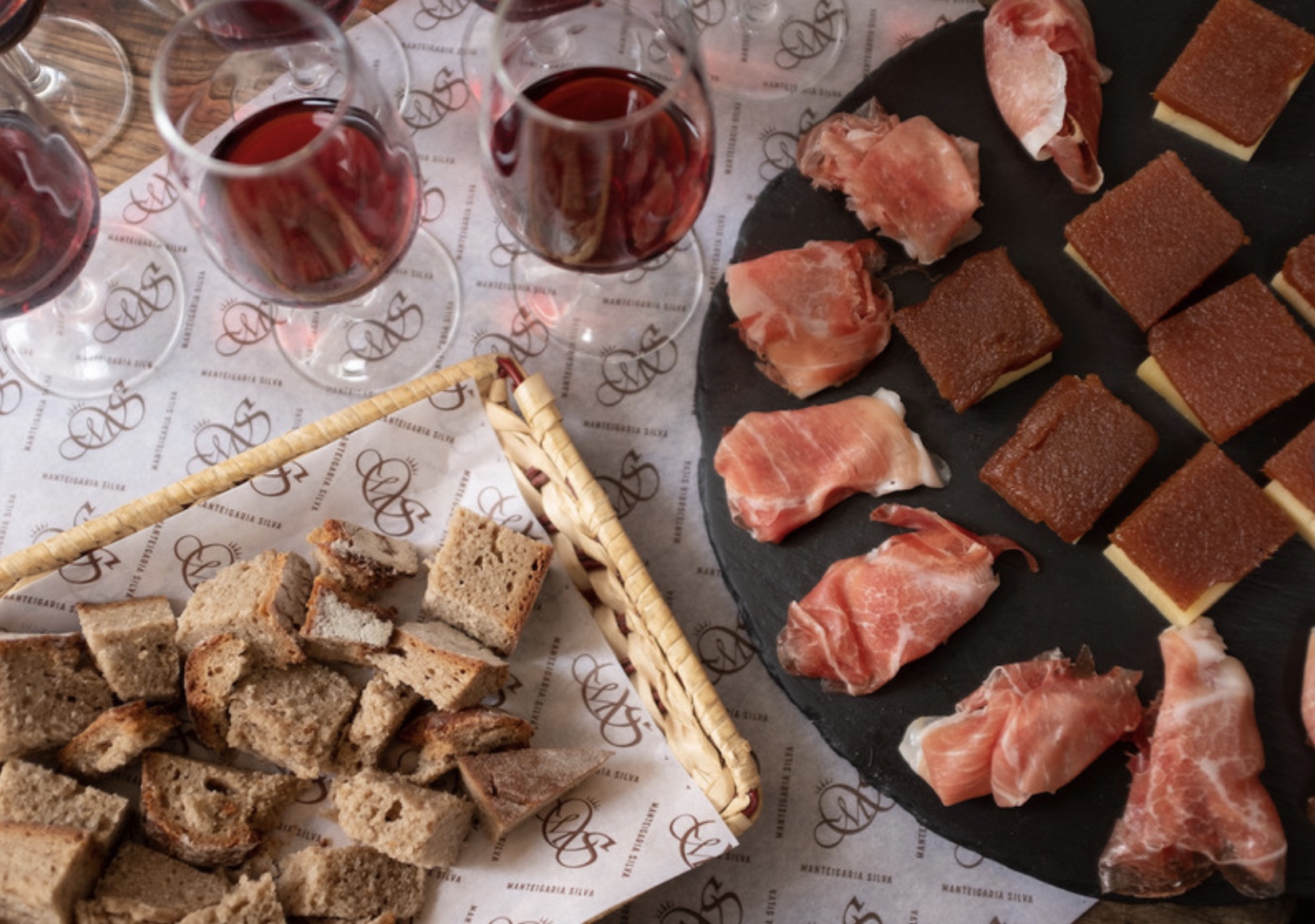
Tawny Porto wine pairing during our Original Food and Wine tour, in Lisbon
When it comes to food pairings for Port wine, of course the best combinations would depend on the kind of Port you are about to drink. If you open a bottle of Vintage Port, the most prized of them all, know that it will go extremely well with dry fruits such as walnuts, apricots and figs, or intense sharp cheeses. Tawny and Colheita also go well with the same kind of food, and it is actually one of the types of Port we use to make food itself – try drizzling a little bit of Tawny on a regular fruit salad and you’ll have yourself a real treat!
Ruby pairs particularly well with rather salty cheeses or, on the sweet side of life, makes for a beautiful combination with dark chocolate.
White Ports can vary a lot, from dry to semi-sweet to rather sweet, and so the recommended wine pairings when it comes to white Porto differ quite a bit too. Dry Port can be sipped as you enjoy an appetizer with salty elements such as marinated olives, cured cheese or even smoked fish such as salmon. While sweet white Ports will work well with typical Portuguese petiscos which mix sweet and salty elements – a combination of cheese and fruit jam would be a good example of this, and so would be a refreshing platter of honeydew melon with cured ham.
Bonus: Port tonic recipe
Port tonic, or Porto tónico, as it is known in Portuguese, is the kind of drink folks into gin tonic are bound to enjoy. When in Portugal, ask for Port tonic to enjoy a local drink and, while at home, if you feel like tasting a little bit of our country between your lips, you can easily make yourself a Port tonic, following these uncomplicated steps.
Theoretically, you can make Port tonic with either red, rosé or white Port, but we are partial to white Porto. It’s as straightforward as mixing ⅓ dry white Port and ⅔ tonic water. Serve the drink in a glass with plenty of ice, a lemon wedge (which you can also massage along the rim of the glass for a more citrusy aroma), garnish with fresh mint leaves and enjoy. Cheers or, as we say here in Portugal, saúde!
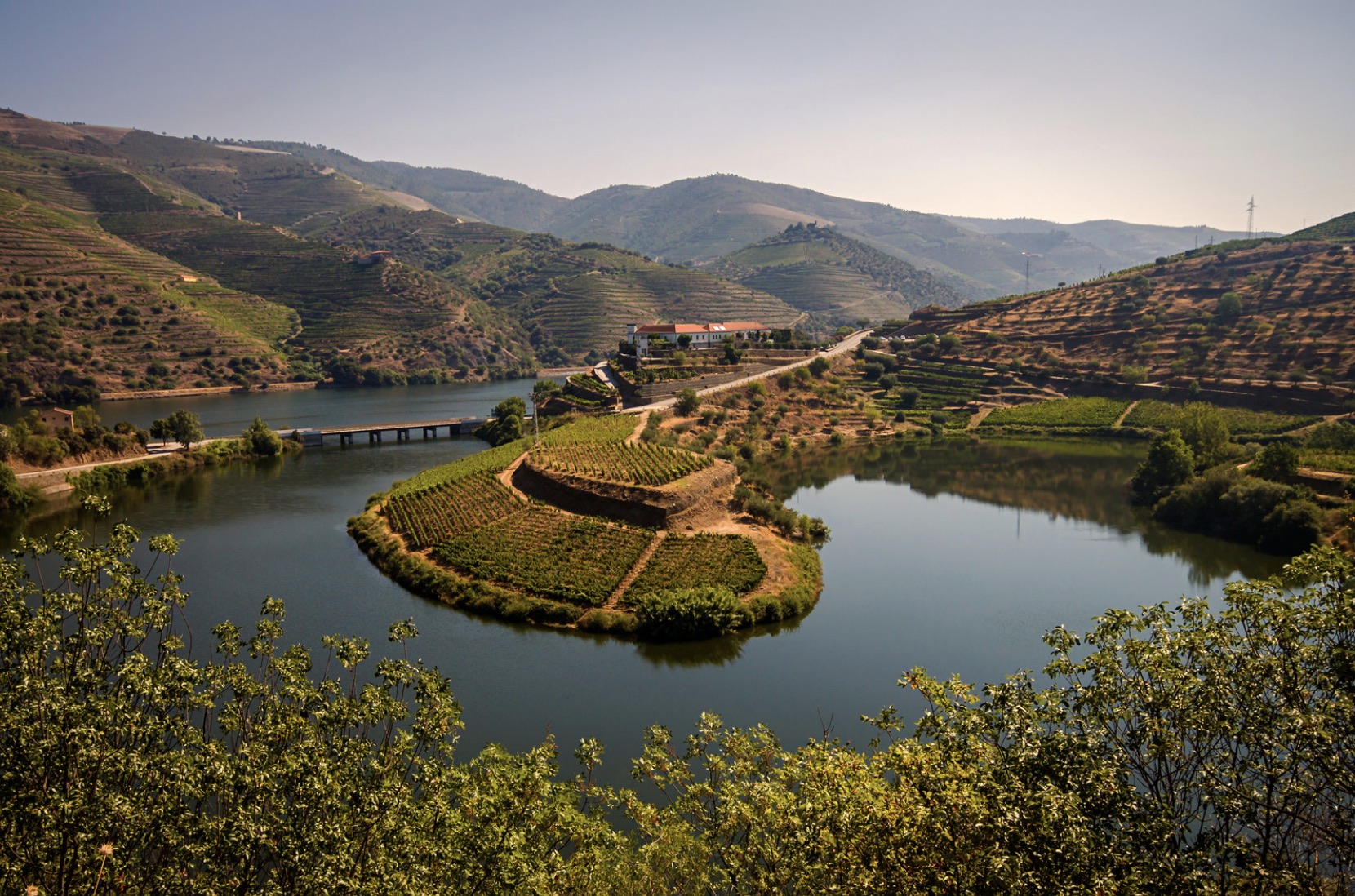
Article by :
Zara Quiroga (freelance food writer and food & cultural leader at Oh! My Cod Pico Trips)
Sílvia Olivença (anthropologist and food guide/CEO at Oh! My Cod Ethnographic Food Tours & Trips)
Photos by:
Sílvia Olivença (anthropologist and food guide/CEO at Oh! My Cod Ethnographic Food Tours & Trips)
Want to more about Portuguese cuisine and its influences?
Pico Wine: one of the world’s most unique wine regions (Genesis – Part I)
How Portugal influenced Indian cuisine
A day trip to Setúbal from Lisbon filled with history, sea culture and incredible cuisine
Minho, Douro and Trás-os-Montes: the cuisines of Northern Portugal (includes Porto!)
Alentejo and Algarve: culinary traditions of the South of Portugal
Alternative beaches near Lisbon and where to eat and drink nearby
